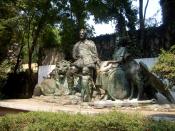U.S. History: Preparing for the Advanced Placement Exam
Chapter 1 - A New World of Many Cultures, 1491-1607
Key Names, Events, and Terms
�
1. Encomienda System: Along the period of time where the famous 1492 Columbus exploration, the rise and birth of the Americas coincided. As a newborn settlement, prosperity was always looked upon. Therefore, Spanish conquistadores turned to a new trustee system called the encomienda system. Initially, this particular system of labor was the door to wealth and power for Spanish masters. The fruits of the laborers came to their leaders. The natives were paid a low wage. It was significant because of the fact that it provided a supply of labor to landowners, so they could benefit from crops in their lands. It defined Spanish America at its earliest.
2. Asiento System: Following the encomienda system, the asiento system took its place. With its same objective, this form of slavery gave approval to other nations to sell slaves to the Spanish colonies for the sake of economic wealth in the late 15th century or so.
In this case, West Africa participated, as many slaves were brought to the Spanish. In this defined organization, the Spanish had to pay a fee to their master for slaves sold. Once again, dominance was the main objective. These original two types of labor contributed to the structure and organization of Early Spanish America. This regulation of trade, somehow, formed the base of the Spanish culture and politics back then.
3. Adena-Hopewell: Along the path of growth of the civilization, Spanish settlements saw a change in culture. They developed more complex cultures so that thousands could cooperate and contribute to their society in the 1500s. New systems of agriculture and architecture, much like the Pueblos, developed.


